At UPMC Children's Hospital of Pittsburgh, we believe parents and guardians can contribute to the success of this surgery and invite you to participate. Please read the following information to learn about the surgery and how you can help.
Velpeau Sling
This sling will be used to protect your child's arm for the first three weeks of recovery after surgery.
While slight adjustments to the sling might be necessary at home, we recommend keeping it on at all times and only adjusting if/when needed.
Your child's arm should not be out of sling until approved by your team. Please keep the sling clean and dry.
If you are unable to adjust the sling at home and/or are having issues keeping it in place, please call UPMC Children's Brachial Plexus Clinic.
After Surgery: What to Expect
When you first see your child after surgery, their arm will be in a sling and they will have leg dressings in place. The sling will be used for the first three weeks and will be removed at an appointment with your team, unless otherwise instructed.

The sling is made of a long stockinette tube. Your child's arm fits inside the tube, leaving one long portion of sling coming off of their hand and the other going up toward his/her neck. There will be padding in the sling, which should go behind the neck when in the proper place.

Adjusting the sling
The most common reason the sling will need to be adjusted is because the arm hole can stretch out towards the elbow. This makes it easier for your child to get their elbow, and then their arm, out of the sling.
When an adjustment is needed, you might notice that their hand is now centered on their belly, or even on the side that was operated on rather than secured across the belly.

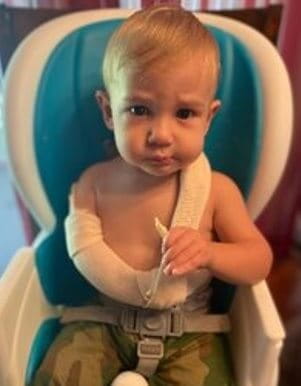
You may need to unclip the safety pins to adjust the sling. We will show you the steps to put it back on should you have to do this.
We will first show you how to secure the "hand piece" (blue) and then the "neck piece" (purple).
You can ignore what the neck piece is doing in the pictures until we get to that part!

Adjusting the sling is likely a two-person job:
- One person to support your child's arm.
- One person to gently adjust the sling.
**In these initial pictures you may notice the arm is unsupported. This child's sling had been discontinued. Photos were taken afterward for educational purposes. You will want to keep a hand on your child's arm to keep it securely in position during adjustment.
Some parents have found it to be helpful to have their child secured in a high chair (if age-appropriate) during the adjustment.

First: Inch the stockinette back up towards the armpit.
It should be close but not tight to avoid pressure/irritation in the armpit.

We recommend then making sure the hand is in the correct position across the chest.
When in the correct position, the fingertips will be close to, or below, the armpit on the other side.

Your next step is to secure the hand across the trunk by wrapping the stockinette from the hand around their belly.
First – go under the arm that didn't have surgery. (blue arrow)
Second – wrap straight across the back until you get to the arm that did have surgery
You will notice the "neck piece" visible from the back. You can still ignore it for now! (purple star)

You will then tuck the stockinette under the arm/armpit of the arm that had surgery so it pulls back through to the front.

Before moving on, please make sure your stockinette has not rolled or twisted, which could make it tight under one or both of the armpits.
It should be open and flat, not pushing tightly into either armpit as shown by a red circle and blue arrow.

Secure this piece by looping it around the bicep and using your safety pin to hold it in place. You should be able to fit your little finger between the clip and their arm.
Cover your safety pin with cloth tape to prevent it from coming unclipped!
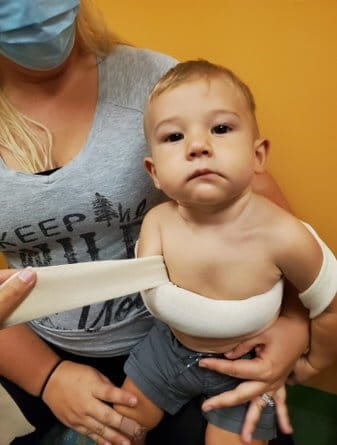
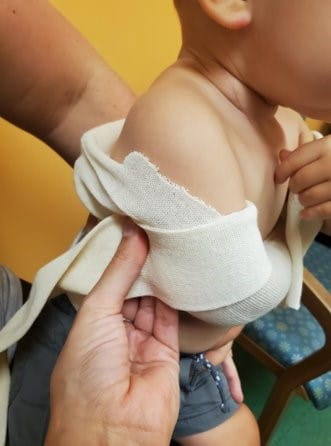

Next - The neck piece!

The "neck piece" has a folded gauze for padding that should fit behind the neck.
First, wrap this piece around the neck, making sure the neck is padded.
Then bring it in front of your child's other shoulder.

You will then tuck the stockinette behind their wrist/hand.
Stop here and again make sure your stockinette has not rolled or twisted anywhere. It should be nice and open, supporting behind the neck and the wrist/hand.

Loop the stockinette around the wrist/hand, as you did with the bicep, and secure with a safety pin.
If the stockinette bunches at the wrist, please flatten it as shown in picture, so it is not tight around wrist.
You should be able to fit your little finger between the safety pin and the wrist to make sure it is not tight.
Cover your safety pin with cloth tape to prevent it from coming unclipped!
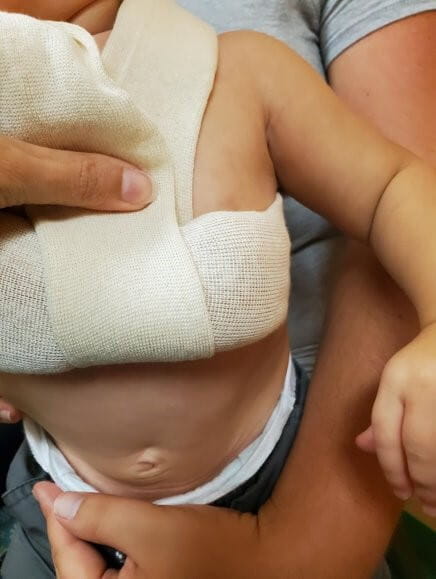

When to Call
If you ever feel that you cannot safely make a sling adjustment, please call.
A six-inch ACE wrap or a snug shirt can be used to gently help keep your child's arm in place pending evaluation.
If you notice irritation around the neck, armpits or wrist.
- Nursing line 7:30 a.m.-3:30 p.m. weekdays at 412-692-6845
- Plastic Surgery On-Call via hospital operator nights/weekends/emergencies at 412-692-5325
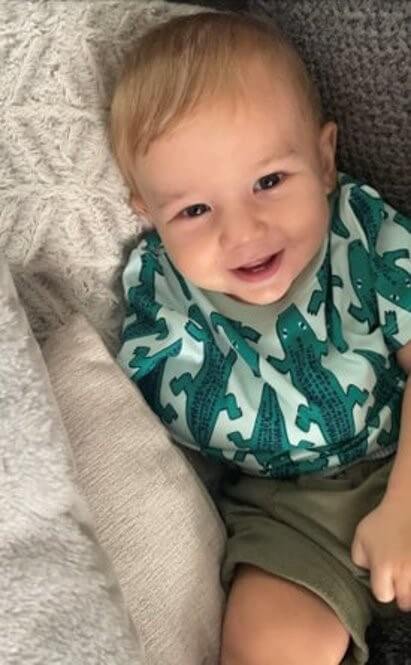
Frequently Asked Questions About Velpeau Sling Management
How do I keep it clean?
Keeping your sling clean can be a challenge. Try a bigger size T-shirt to go over top and change as needed. This and/or a large bib can be very helpful at meal times!
- A shirt can also help reinforce the sling by adding a layer to help keep it snug.
- It also keeps curious fingers away from safety pins!

Can my child sleep in the sling?
Yes. We recommend the sling be on at all times. By the time of surgery some children have figured out rolling. It is not advised to prop your child to keep them on their back. If they have figured out how to roll, they are allowed to roll.
Can my child go in a car seat?
Yes. The car seat goes over top of the sling.
Can my child crawl in the sling?
We recommend caution with activities as they won't be able to catch themselves if they tip to the side with the sling. However, they can have monitored activities. If they try to crawl or scoot with the other arm, that is OK; we just recommend caution and limiting this if you are not immediately present.
- Depending on your child's age, seats with tables like Bumbo® chairs, activity chairs, and high chairs are great ways for safe play!

































